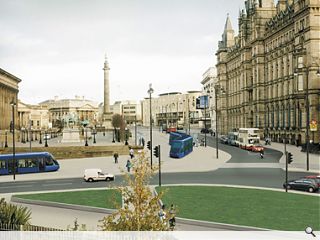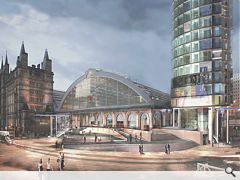Liverpool is planning a number of new additions to its transport infrastructure, including a tram. But will the Capital of Culture 2008 be able to deliver an integrated system suited to the 21st century ?
17 Dec 2004
Spare a thought for engineer George Stephenson, trying to create the Liverpool to Manchester rail link that was to become the world’s first passenger railway. In 1824 he wrote: “We have sad work with Lord Derby, Lord Sefton, and Bradshaw the Great Canal Proprietor, whose grounds we go through with the projected railway. Their ground is blockaded on every side to prevent us getting on with the Survey – Bradshaw fires guns through his grounds in the course of the night to prevent the surveyors coming on in the dark – Lord Sefton says he will have a hundred men against us – the (Liverpool Railway) Company thinks those Great men have no right to stop a survey.”
Fast-forward nearly two hundred years and while (hopefully) no-one’s looking down the barrel of a gun, Liverpool’s transport issues are just as frustrating and fraught. Liverpool has embarked on a hugely exciting phase in its history, with celebrations for its 800th anniversary in 2007, and Capital of Culture in 2008 providing the impetus. The transport needs of the anticipated 1.7 million visitors, not to mention the long-suffering locals, have to be met. It’s a rare opportunity for a well-designed integrated transport system, and on paper it looks good. Crucial improvements to the city’s arrival points, or gateways, for air, train and road users, a new light transit (tram) system and integrated transport hubs are all planned.
These schemes, however, are led by an array of private and public sector groups with no single umbrella organisation co-ordinating the complex and sometimes conflicting agendas. The Merseyside Express Tramway (MET) is the thread that quite literally binds everything together, and in this sense is crucial to the fulfilment of Liverpool’s ambitions, yet routes are still being discussed and no firm design decisions have been made. The Paradise Street retail development, the Lime Street Gateway, the Liverpool South Parkway (multi-transport interchange at Allerton), the proposed cruise liner terminal at the Pier Head and the new Mersey Crossing at Runcorn are all major projects that have “designed in” potential tram lines and stops.
Everyone seems to want the trams to happen, but they can hardly be blamed for feeling sceptical. Delayed decisions, squabbles over routes and interminable consulting make everyone nervous, but Neil Scales, chief executive and director general of Merseytravel, the passenger transport authority that will run the MET, is confident. “The tram project is vitally important to Liverpool’s ambitions to become a top twenty European city destination. Every major European city has a tram system that adds to its permeability. Trams provide accessible, environmentally friendly public transport.” The good news is that design is firmly, if belatedly, on the agenda for Liverpool’s transport plans. For the trams, adds Scales, “Design is also extremely important. The system must be modern while blending in with the streetscape and complementing the many heritage buildings. Good design can improve efficiency in a great number of ways, including cleansing, maintenance and providing a system that will stand the test of time. A number of design proposals have been received, which are being discussed, but we can say nothing further because the bid to build and operate Merseytram is currently being assessed.”
So Liverpool is at last raising the architectural bar, at least in the city centre, with commissioning at a high level and an apparent willingness from clients to push quality up the agenda. Wilkinson Eyre is designing the new bus and tram station for the 42-acre Paradise Street retail development, a scheme backed by Grosvenor, the Duke of Westminster’s property company. Urban Initiatives and Glenn Howells Architects has been commissioned to remodel the cluttered 1960s frontage of Lime Street, Liverpool’s main railway station. The client is Liverpool Vision and English Partnerships is the lead investor, though a new tower to replace the unloved Concourse House will be privately funded.
“There’s a recognition in both the private and public sector that good design has an impact on commercial outcomes,” says Beatrice Fraenkel, Liverpool City Council’s designated design champion. Fraenkel has worked closely with CABE to encourage clients to approach projects more creatively. “We’re aiming to effect a sea change in thinking among clients,” she explains. “But we also have to ensure public money is spent on quality, and to show clients that it doesn’t necessarily cost more,” she adds. “They will end up spending more in the long term if they don’t, especially with buildings like transport terminals with heavy traffic.”
Liverpool Vision and Liverpool City Council have also implemented £72m worth of public realm works to improve traffic and pedestrian flow, the City Centre Movement Strategy (CCMS). “The CCMS is an overarching initiative with quality embedded in its implementation framework,” says Liverpool Vision Project Director Kerri Farnsworth. “It’s about getting quality accepted as standard by all the public sector partners, and maintaining consistency by narrowing down the contractors to just three companies, for example.”
The Lime Street Gateway is arguably the most important public space to benefit, adds Farnsworth, but warns that it’s not merely for 2008. “It’s a ten-year strategy for the station environment, and the sheer volume of public response on the feedback forms makes it clear that the station has great symbolic importance for local people, there is a strong sentimental attachment. From the outside its name is on a par with London stations and it also has a unique railway heritage, with a fantastic arrival experience through the tunnels and then emerging into a beautiful train shed. But it’s confusing and deflating after that, and we want to bring back the sense of excitement and grandeur.”
In a sense, the Lime Street Gateway project is about designing the spaces in between the buildings, says Paul Scott, Director at Glenn Howells Architects. “Liverpool has an amazing series of spaces, from the Pier Head up to St George’s Hall and the station, but the links need re-instating, particularly between the cultural and the retail areas. Despite the financial investment, it’s really quite a simple shift, to clear away inappropriate development around the station but also to open up the views and make it more pedestrian-orientated. It sounds grand, but it’s about sharing civic pride, both for daily users and visitors.”
The scheme has to be flexible enough to deal with a future transport proposal that may not happen, while creating a unified public identity, says Scott. “At present, people are thrown out onto the street too quickly and can’t get orientated. We aim to restore the ceremonial entrance and sense of civic space.” The new tower will have residential accommodation on the higher levels but a public base. “It’s a holistic approach with a serious environmental agenda to stimulate the generation of a credible community. The payback is massive and exponential.”
Trying to untangle the melee of cars, buses, taxis, coaches, cyclists and pedestrians that constitutes Liverpool city centre (and most others) at the moment, finding space for them all to stop, turn, cross and move without impeding or endangering one another, and then adding trams to the mix, is a daunting task. Architectural concerns may seem a low priority but no-one needs telling that points of arrival and departure are emotional, even spiritual, places, so why have we accepted depressing dross for so long? “We still hanker after the Victorian model, the cathedral of travel that lifts the senses,” says architect Keith Brownlie, a Director at Wilkinson Eyre, the practice responsible for the joyful “blinking eye” pedestrian bridge that crosses the Tyne between Newcastle and Gateshead.
These aspirations were lost in the 20-century drive for efficiency and economy, says Brownlie, and it’s only commerce that makes the client go the extra mile now. Wilkinson Eyre’s design for the new transport interchange at Liverpool’s new Paradise Street retail development will aim to recover the spatial qualities lacking in so many post-war transport buildings, he says. It’s a combination of bus, tram and taxi movement with an underground car park and pedestrian link bridge to the new John Lewis store. “It’s about clarity. All building projects should be about people, and particularly transport, where people are waiting, whether for five minutes or an hour. It’s got to be a vibrant experience for passengers. We want to transcend all the constraints to create notable, memorable buildings that are not just incidental to the transport infrastructure. That’s what good design can do.”
Despite recent improvements and exciting plans, it remains a massive challenge for a city with poor arrival experiences, lack of facilities and pathetic onward travel arrangements, at Lime Street station, the Pier Head, John Lennon Airport, the Runcorn Bridge and the abrupt end of the M62 at Edge Lane. The importance for business communications cannot be underestimated, warns Steve Pearse, transport specialist at the Liverpool Chamber of Commerce. “We have quality aspirations not only in materials and design but also aspects such as safety, security, customer care and user information. There’s great enthusiasm for projects such as the new Mersey Crossing, which will have a huge impact on Merseyside but also feed further transport links to the region and beyond. The trams would also reduce atmospheric pollution, which would benefit buildings as well as people. But it’s absolutely vital to get it right. Today’s casual visitor could be tomorrow’s investor.”
by Deborah Mulhearn
Read previous: Some of the country\'s flashiest home Christmas displays
Back to December 2004
Browse Features Archive
Search
News
For more news from the industry visit our News section.
Features & Reports
For more information from the industry visit our Features & Reports section.




